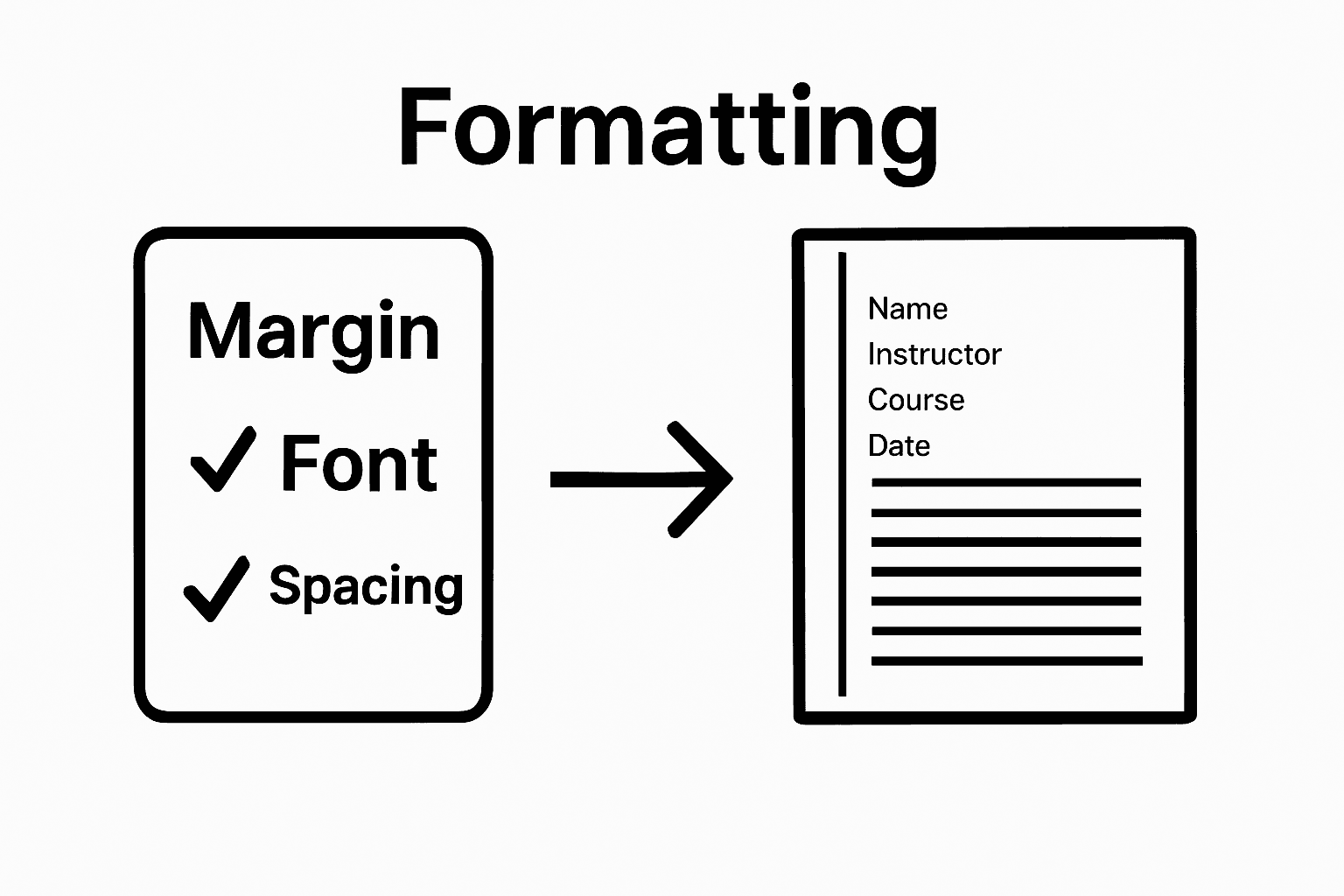Blog
Learning Materials
Master Essay Header Format for Academic Success
Updated: August 27, 2025

Formatting an academic paper might look simple at first glance. Yet, missing the right header or using the wrong font can drop your grade by a full letter. Most students think great content matters most but even the smartest essay can get knocked down if the format misses a single detail. That means getting every margin, header, and spacing requirement right is as important as the words themselves.
Table of Contents
- Step 1: Gather Necessary Formatting Guidelines
- Step 2: Choose Your Essay Header Style
- Step 3: Apply Consistent Formatting Elements
- Step 4: Include Essential Information In The Header
- Step 5: Review And Adjust Header Alignment
- Step 6: Verify Header Compliance With Requirements
Quick Summary
| Key Point | Explanation |
|---|---|
| 1. Gather formatting guidelines first | Understanding the required formatting style ensures your document meets academic standards from the beginning. |
| 2. Choose the correct header style | Select the header format based on your academic discipline, as different styles communicate professional standards. |
| 3. Maintain consistent formatting elements | Consistency in font, spacing, and margins gives your paper a polished look and reflects attention to detail. |
| 4. Include essential information in the header | Your header should contain critical information like your name and course details to enhance professionalism and recognition. |
| 5. Systematically verify header compliance | A thorough final check of header details ensures that your document adheres to specific formatting requirements, avoiding potential errors. |
Step 1: Gather Necessary Formatting Guidelines
Successful academic writing begins with understanding the specific formatting requirements for your essay. Before you start drafting, collecting the precise guidelines is crucial to creating a polished, professional document that meets academic standards. This step involves carefully examining the formatting specifications provided by your instructor or academic institution.
Start by reviewing the specific style guide required for your assignment. Most academic papers follow standard formats like MLA, APA, or Chicago Style. Each style has unique requirements for margins, font, spacing, and header information. Locate the official style guide or detailed instructions from your course syllabus or assignment prompt. Pro tip: If your instructor hasn't specified a style, ask for clarification before beginning your research.
Key formatting elements you'll need to gather include page margins, font type and size, line spacing, and header specifications. Typically, academic papers require 12-point Times New Roman font, double spacing, and 1-inch margins on all sides. The header format varies by style guide, but most require your last name and page number in the top right corner. Some instructors might request additional information like your name, course title, or assignment date in the header.
To ensure accuracy, create a quick reference checklist of formatting requirements. Check out our comprehensive writing format guide to help you compile these details systematically. Your checklist should include:
- Exact page margin specifications
- Required font type and size
- Spacing requirements
- Header and page numbering guidelines
- Any special formatting instructions
Don't rush this preliminary step. Taking time to gather and verify formatting guidelines will save you significant editing time later and help you avoid potential point deductions for formatting errors. Remember, even the most brilliant content can be undermined by improper formatting, so approach this step with careful attention to detail.

Step 2: Choose Your Essay Header Style
Selecting the appropriate header style is a critical decision that sets the professional tone for your academic document. Different academic disciplines and institutions prefer specific formatting styles, each with unique header requirements that communicate essential information about your work. Your goal in this step is to match your header precisely to the expected academic standards.
The most common header styles include MLA, APA, and Chicago Style, each with distinct formatting nuances. For most undergraduate papers, MLA and APA are the most frequently used. MLA headers typically include your last name and page number in the top right corner, while APA headers can vary between student and professional papers. Professional APA papers require a running head with an abbreviated title, whereas student papers simply need page numbers.
To determine the right header style, carefully review your assignment instructions or consult your course syllabus. Some instructors have very specific requirements that might deviate from standard style guide recommendations. Pay close attention to these details, as formatting can impact your overall grade. If no specific style is mandated, choose the style most common in your academic discipline. Humanities typically use MLA, social sciences prefer APA, and history or literature courses often request Chicago Style.
Below is a comparison of the most common academic header styles to help you select the one that best fits your assignment requirements.
| Header Style | Typical Use | Key Header Elements | Top Margin |
|---|---|---|---|
| MLA | Humanities, literature | Last name & page number (top right); info block on page 1 | 0.5 inch |
| APA | Social sciences, psychology | Page number (top right), running head (professional papers) | 0.5 inch |
| Chicago | History, fine arts | Page number (top right or bottom); no info block | 0.5-1 inch |
Learn more about advanced essay formatting techniques to ensure you select the most appropriate header style for your specific academic context. Your header should include critical information such as:
- Your full name
- Course name and number
- Instructor's name
- Submission date
- Page numbers
Before finalizing your header, double-check that it meets all specified requirements. Verify the font, alignment, and placement of each element. A well-crafted header demonstrates your attention to detail and academic professionalism, setting a strong foundation for the content that follows.
Step 3: Apply Consistent Formatting Elements
Consistent formatting transforms a good academic paper into a professional document. This step focuses on meticulously applying uniform design elements that create a polished, cohesive appearance across every page of your essay. Consistency demonstrates academic discipline and attention to detail, signaling to instructors that you understand scholarly writing standards.
Begin by establishing a uniform font strategy. Most academic styles require 12-point Times New Roman, but always confirm your specific guidelines. Ensure the same font appears throughout your document, including headers, body text, and reference sections. Pay special attention to maintaining consistent font size, with headings potentially using slightly larger or bolded variations while preserving overall uniformity.
Spacing and alignment are critical components of consistent formatting. Double-space the entire document, including headers, body paragraphs, and references. Set all margins to one inch on all sides, creating a clean, professional frame for your text. Use your word processor's automatic alignment and spacing tools to maintain precision. Most academic writing requires left-aligned text with a ragged right margin, which prevents awkward stretching of words.
Explore advanced formatting techniques for academic writing to elevate your document's professional appearance. When applying formatting, focus on these key consistency elements:
- Identical font throughout the document
- Consistent margin sizes (1 inch on all sides)
- Uniform double-spacing
- Standardized header information
- Consistent paragraph indentation
Finalize your formatting by performing a comprehensive review. Scroll through each page to verify that no section deviates from your established formatting rules. Check page numbers, headers, and overall visual consistency. A perfectly formatted document communicates scholarly discipline and respects academic writing conventions, setting a strong foundation for your academic work.
Step 4: Include Essential Information in the Header
The header is more than a decorative element; it's a critical communication tool that provides key identifying information about your academic work. Each academic style guide prescribes specific requirements for header content, making it essential to understand and implement these guidelines precisely. Your goal is to create a header that professionally represents your document while meeting strict academic standards.
MLA and APA styles have distinctive header requirements that demand careful attention. In MLA format, your header should include your last name and consecutive page numbers in the top right corner, positioned one-half inch from the top edge. For the first page, you'll also need a left-aligned block with your full name, instructor's name, course title, and submission date. APA student papers typically require only page numbers in the top right corner, creating a cleaner, more minimalist approach.
The information you include communicates professionalism and helps instructors and researchers quickly identify and track your document. Precision is key. Ensure your name is written exactly as it appears on official school documents, use the full course name as listed in your syllabus, and verify the submission date format matches your institution's requirements. Some departments have specific preferences for date formatting (month-day-year versus day-month-year), so confirm these details beforehand.
Discover advanced strategies for perfecting your academic document headers to elevate your scholarly writing. When preparing your header, compile and verify these essential elements:
- Full legal name
- Complete course name and number
- Instructor's full name
- Exact submission date
- Consistent page numbering
Complete your header preparation by performing a final cross-check. Verify that each piece of information is accurate, properly formatted, and consistent with your chosen style guide. A well-constructed header not only meets academic standards but also demonstrates your commitment to scholarly precision and attention to detail.
This checklist table organizes the essential formatting elements you should confirm are correctly applied before finalizing your academic paper header.
| Formatting Element | Requirement/Standard | Verified? |
|---|---|---|
| Font type and size | 12-pt Times New Roman | |
| Margin size | 1 inch on all sides | |
| Line spacing | Double-spaced throughout | |
| Header info (name, page) | As specified by style guide | |
| Page number placement | Top right, 0.5 inch margin | |
| Instructor/course details | As required by instructions | |
| Submission date format | Matches institutional standard | |
| Alignment & consistency | Uniform across all pages |
Step 5: Review and Adjust Header Alignment
Header alignment might seem like a minor detail, but it's a critical element that demonstrates your attention to academic formatting standards. Precise alignment communicates professionalism and shows your understanding of scholarly document preparation. Each style guide has specific requirements for header positioning that must be followed meticulously.
Microsoft Word and Google Docs offer powerful tools to help you achieve perfect header alignment. For most academic styles, you'll want to set your header one-half inch from the top of the page, with page numbers positioned in the upper right corner. Use the ruler function or page layout settings to ensure consistent placement. Pro tip: Enable the ruler view in your word processor to make precise measurements easier. Some students struggle with accidentally creating multiple headers or inconsistent spacing, so take your time and verify each page's alignment carefully.
MLA and APA styles have nuanced alignment requirements that demand careful implementation. In MLA format, your last name and page number should appear flush right, aligned precisely without additional spaces or punctuation. APA student papers require page numbers in the top right corner, positioned exactly one-half inch from the page's top edge. Some word processors have automatic header functions, but always double-check these automated settings to ensure they meet your specific style guide requirements.
Explore advanced document formatting techniques to perfect your academic paper's appearance. When reviewing your header alignment, focus on these critical verification points:
- Consistent top margin (1/2 inch)
- Right-aligned page numbers
- Uniform font and size
- No extra spaces or characters
- Identical placement on every page
Complete your alignment review by printing a test page or using your word processor's print preview function. Carefully examine the header's position, checking that it meets all specified formatting requirements. Remember, perfect alignment is the hallmark of a well-prepared academic document.

Step 6: Verify Header Compliance with Requirements
Verifying header compliance is the final critical checkpoint in your academic document preparation. This step transforms your draft from a simple document into a professionally formatted academic submission. Your goal is to meticulously confirm that every element of your header meets the specific requirements of your chosen style guide, leaving no room for potential formatting errors.
Systematic verification is key to header perfection. Begin by creating a comprehensive checklist that matches your specific academic style guide. For MLA and APA formats, this means paying close attention to page numbering, name placement, and precise margin requirements. Check each page individually, ensuring consistent formatting throughout the document. Many students overlook subtle details like spacing, font size, and exact header positioning, which can result in unnecessary point deductions.
Utilize digital and manual verification techniques to ensure absolute accuracy. Most word processing software offer built-in formatting review tools that can help identify potential inconsistencies. Print a physical copy of your document to perform a hands-on review, as digital screens can sometimes mask formatting issues. Measure margins with a ruler, verify page number placement, and confirm that your header appears identical on every page. Pay special attention to the first page, which often has unique formatting requirements in academic styles.
Discover advanced document compliance strategies to elevate your academic submission. When verifying header compliance, focus on these critical elements:
- Consistent page number placement
- Correct font and size for header text
- Precise one-half inch margin from top edge
- Accurate surname or identifying information
- Matching header format across all pages
Complete your verification by asking a classmate or academic peer to review your document. A fresh set of eyes can often catch formatting nuances you might have missed. Remember, in academic writing, meticulous attention to header formatting demonstrates your commitment to scholarly precision and professional presentation.
Transform Your Academic Formatting with Samwell.ai’s Precision Tools
Struggling to master essay header formatting can be stressful, and it is easy to lose points over small mistakes like page number placement or inconsistent spacing. You read how essential it is to follow MLA and APA rules, keep margins and headers perfectly aligned, and verify compliance on every page. It can be overwhelming to keep track of every little detail.

Imagine having every formatting rule handled for you instantly. With Samwell.ai, you do not need to worry about missing margins or incorrect headers. Our platform features advanced tools that automatically apply academic style guides, prevent costly errors, and let you focus on your ideas instead of formatting struggles. Explore our Power Editor for targeted editing, or use our real-time compliance checks to perfect every academic detail. Join over a million students who trust Samwell.ai for stress-free academic success. Set up your free account at Samwell.ai and see the difference for yourself today.
Frequently Asked Questions
What are the common essay header styles used in academic writing?
Common essay header styles include MLA (Modern Language Association), APA (American Psychological Association), and Chicago Style. Each style has unique formatting requirements for the header, which must be followed according to specific academic guidelines.
How do I format my header according to MLA style?
In MLA format, the header includes your last name and page number in the top right corner, positioned half an inch from the top. Additionally, the first page requires a left-aligned block that features your full name, instructor's name, course title, and submission date.
What must I include in my essay header for APA format?
For APA format, student papers typically require only the page number in the top right corner, while professional papers need a running head with an abbreviated title. Always check your specific assignment requirements for more details.
Why is consistent formatting important in an academic essay?
Consistent formatting is crucial in academic writing because it demonstrates professionalism and attention to detail. It helps to create a polished appearance that adheres to academic standards, reducing the risk of point deductions for formatting errors.
Recommended
Generate essays with Samwell.ai
Whether you’re a publisher, professor, journalist, or student, let us tailor a plan just for you.Most Read Articles

Your Guide to Help Writing a Essay Successfully
Expert tips for help writing a essay - from crafting a thesis to structuring your essay effectively.

How to Write Critical Thinking Essay: Expert Tips
Expert tips for writing a critical thinking essay. Learn how to structure, choose topics, and use evidence effectively.'

How to Write a Good Hook: A Step-by-Step Guide
Master the art of crafting a good hook with our guide. Create compelling openers for a memorable first impression.

